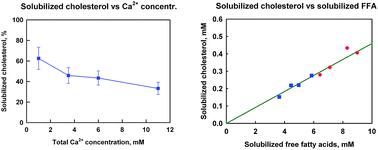 Lipid digestion has been widely studied because of its impact on human health and the food and pharmaceutical industries. However, ethical issues make in vivo human studies difficult, therefore, numerous in vitro digestion models have been developed which mimic the conditions in the gastro-intestinal tract (GIT). Dairy calcium has been shown to affect fat lipolysis and can reduce body weight and LDL cholesterols. However, the mechanism by which calcium lowers the blood cholesterol remains unclear.
Lipid digestion has been widely studied because of its impact on human health and the food and pharmaceutical industries. However, ethical issues make in vivo human studies difficult, therefore, numerous in vitro digestion models have been developed which mimic the conditions in the gastro-intestinal tract (GIT). Dairy calcium has been shown to affect fat lipolysis and can reduce body weight and LDL cholesterols. However, the mechanism by which calcium lowers the blood cholesterol remains unclear.
In this work, Slavka Tcholakova and co-workers have developed a simple in vitro model for triglyceride (TG) lipolysis which mimics closely the conditions in the human stomach and small intestine. In this new model the pH profile in the small intestine is closely matched to real conditions using a bicarbonate buffer and the experimental procedure does not include complex equipment. In their study the proposed in vitro model was used to assess the effects of Ca2+, pH, and bicarbonate on the degree of TG lipolysis and on the solubilization of the lipolysis products and cholesterol in the aqueous phase. The model is also appropriate for studying other phenomena making it a versatile tool for studying the lipid-related phenomena occurring in the gastrointestinal tract.
Read the article for free until 18th September by clicking the link below:
In vitrostudy of triglyceride lipolysis and phase distribution of the reaction products and cholesterol: effects of calcium and bicarbonate, Zahari Vinarov, Liliya Petrova, Slavka Tcholakova, Nikolai Denkov Denkov, Simeon D. Stoyanov and Alex Lipse, Food Funct., 2012, DOI: 10.1039/c2fo30085k
You may also be interested in this review article, also free to access:
Review of in vitro digestion models for rapid screening of emulsion-based systems, David Julian McClements and Yan Li, Food Funct., 2010, 1, 32-59
You can keep up to date with the latest developments from Food & Function by signing up for free table of contents alerts and monthly e-newsletters.










